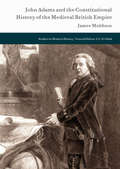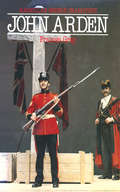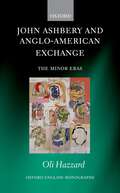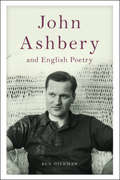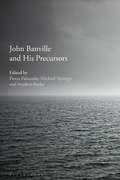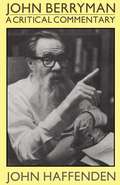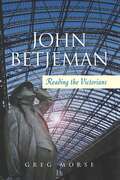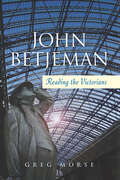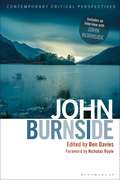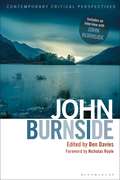- Table View
- List View
John Adams and the Constitutional History of the Medieval British Empire
by James MuldoonThis book contributes to the increasing interest in John Adams and his political and legal thought by examining his work on the medieval British Empire. For Adams, the conflict with England was constitutional because there was no British Empire, only numerous territories including the American colonies not consolidated into a constitutional structure. Each had a unique relationship to the English. In two series of essays he rejected the Parliament’s claim to legislate for the internal governance of the American colonies. His Dissertation on the Canon and Feudal Law (1765) identified these claims with the Yoke, Norman tyranny over the defeated Saxons after 1066. Parliament was seeking to treat the colonists in similar fashion. The Novanglus essays (1774-75), traced the origin of the colonies, demonstrating that Parliament played no role in their establishment and so had no role in their internal governance without the colonists’ subsequent consent.
John Adams and the Constitutional History of the Medieval British Empire
by James MuldoonThis book contributes to the increasing interest in John Adams and his political and legal thought by examining his work on the medieval British Empire. For Adams, the conflict with England was constitutional because there was no British Empire, only numerous territories including the American colonies not consolidated into a constitutional structure. Each had a unique relationship to the English. In two series of essays he rejected the Parliament’s claim to legislate for the internal governance of the American colonies. His Dissertation on the Canon and Feudal Law (1765) identified these claims with the Yoke, Norman tyranny over the defeated Saxons after 1066. Parliament was seeking to treat the colonists in similar fashion. The Novanglus essays (1774-75), traced the origin of the colonies, demonstrating that Parliament played no role in their establishment and so had no role in their internal governance without the colonists’ subsequent consent.
John Ashbery and American Poetry
by David HerdDavid Herd sets out to provide readers with a new critical language through which they can appreciate the beauty and complexity of Ashbery’s writing.Presenting the poet in all his forms –avant-garde, nostalgic, sublime and camp – the book argues that the perpetual inventiveness of Ashbery’s work has always been underpinned by the poets desire to write the poem fit to cope with its occasion.Tracing Ashbery’s development in the light of this idea, and from its origins in the dazzling artistic environment of 1950’s New York, the book evaluates his poetry against the aesthetic, literary and historical backgrounds that have informed it.The story of a brilliant career, and a history of the period in which that career has taken shape, John Ashbery and American Poetry provides a compelling account of Ashbery’s importance to Twentieth Century Literature.
John Ashbery and Anglo-American Exchange: The Minor Eras (Oxford English Monographs)
by Oli HazzardIn 1966, John Ashbery wrote: 'The English language is constantly trying to stave off invasion by the American language; it lives in a state of alert which is reflected to some degree in English poetry.' This book shows how the work of a major post-war American poet has been centrally concerned with questions of national identity and intercultural poetic exchange, by reading crucial episodes in Ashbery's oeuvre in the context of an 'other tradition' of modern English poets he himself has defined. This line runs from the editor of Ashbery's recent Collected Poems, Mark Ford, through Lee Harwood in the late 1960s, F. T. Prince in the 1950s, to 'chronologically the first and therefore most important influence' on his own work, W. H. Auden. Through detailed close readings of the poetry of Ashbery and these English poets, original interviews, and extensive archival research, a new account of Ashbery's aesthetic, and a significant re-mapping of post-war English poetry, is presented. The biographical slant of the book is highly significant, as it reads these writers' poetry and correspondence together for the first time, suggesting how major poetic innovations arose from specific social contexts, from the particulars of relations between poets, and also from a broader climate of Anglo-American exchange as registered by each poet. The book's presentation of the process of poetic influence is attentive to actual exchanges between contemporaries as evidenced in correspondence, as opposed to speculative relationships with dominant figures, and as such represents a departure from many other studies of Ashbery's work. Key themes include 'Englishness' as a national imaginary, the concept of the 'minor', reciprocal influence, and the poetry of coteries. The result is that both Ashbery himself, and the landscape of post-war English poetry, are presented in significantly new lights.
John Ashbery and Anglo-American Exchange: The Minor Eras (Oxford English Monographs)
by Oli HazzardIn 1966, John Ashbery wrote: 'The English language is constantly trying to stave off invasion by the American language; it lives in a state of alert which is reflected to some degree in English poetry.' This book shows how the work of a major post-war American poet has been centrally concerned with questions of national identity and intercultural poetic exchange, by reading crucial episodes in Ashbery's oeuvre in the context of an 'other tradition' of modern English poets he himself has defined. This line runs from the editor of Ashbery's recent Collected Poems, Mark Ford, through Lee Harwood in the late 1960s, F. T. Prince in the 1950s, to 'chronologically the first and therefore most important influence' on his own work, W. H. Auden. Through detailed close readings of the poetry of Ashbery and these English poets, original interviews, and extensive archival research, a new account of Ashbery's aesthetic, and a significant re-mapping of post-war English poetry, is presented. The biographical slant of the book is highly significant, as it reads these writers' poetry and correspondence together for the first time, suggesting how major poetic innovations arose from specific social contexts, from the particulars of relations between poets, and also from a broader climate of Anglo-American exchange as registered by each poet. The book's presentation of the process of poetic influence is attentive to actual exchanges between contemporaries as evidenced in correspondence, as opposed to speculative relationships with dominant figures, and as such represents a departure from many other studies of Ashbery's work. Key themes include 'Englishness' as a national imaginary, the concept of the 'minor', reciprocal influence, and the poetry of coteries. The result is that both Ashbery himself, and the landscape of post-war English poetry, are presented in significantly new lights.
John Ashbery and English Poetry: The Making of the English Epyllion
by Ben HickmanA study of how we should read one of America's most important poets
John Banville and His Precursors
by Pietra Palazzolo Michael Springer Stephen ButlerBringing together leading international scholars, John Banville and His Precursors explores Booker and Franz Kafka prize-winning Irish author John Banville's most significant intellectual influences. The book explores how Banville's novels engage deeply with a wide range of sources, from literary figures such as Samuel Beckett, Heinrich von Kleist, Wallace Stevens, Rainer Maria Rilke, and Henry James, to thinkers such as Freud, Heidegger, and Blanchot. Reading the full range of Banville's writings - from his Booker Prize-winning novel The Sea to his latest book, Mrs Osmond – John Banville and His Precursors reveals the richness of the author's work. In this way, the book also raises questions about the contemporary moment's relationship to a variety of intellectual and cultural traditions -– Romanticism, Modernism, existentialism -– and how the significance of these can be appreciated in new and often surprising ways.
John Banville and His Precursors
by Pietra Palazzolo Michael Springer Stephen ButlerBringing together leading international scholars, John Banville and His Precursors explores Booker and Franz Kafka prize-winning Irish author John Banville's most significant intellectual influences. The book explores how Banville's novels engage deeply with a wide range of sources, from literary figures such as Samuel Beckett, Heinrich von Kleist, Wallace Stevens, Rainer Maria Rilke, and Henry James, to thinkers such as Freud, Heidegger, and Blanchot. Reading the full range of Banville's writings - from his Booker Prize-winning novel The Sea to his latest book, Mrs Osmond – John Banville and His Precursors reveals the richness of the author's work. In this way, the book also raises questions about the contemporary moment's relationship to a variety of intellectual and cultural traditions -– Romanticism, Modernism, existentialism -– and how the significance of these can be appreciated in new and often surprising ways.
John Banville's Narcissistic Fictions: The Spectral Self
by M. O'ConnellIn reading Banville's novels through the work of key psychoanalytical theorists, John Banville's Narcissistic Fictions brings together apparently disparate thematic strands - missing twins, shame, false identities - and presents these as manifestations of a central concern with narcissism.
John Berger: Ways of Learning (My Reading)
by Iona HeathIona Heath relates the importance that John Berger's work and friendship had on her working life as a GP. It includes extracts from letters that span 20 years of her correspondence with John Berger. In this book, Iona Heath writes about reading John Berger's writing over more than 50 years and her friendship and correspondence with him over the best part of 20 years. Dr Heath found that both of these interacted profoundly with her work as a general practitioner in a deprived urban area in London. For Iona Heath, general practice is a quite extraordinary undertaking: every working day, sitting with a succession of unique individuals, each worried about some aspect of their health or life circumstances, many burdened by unspoken fears, and each seeking some form of answer. Starting with A Fortunate Man, when she was an ignorant but hopeful undergraduate medical student, she found reading John Berger on any subject had something new to tell her about the aspirations and detail of her work: clues about how to look and how to listen and much else. Later when they started to correspond, Iona Heath found herself in the privileged position of being able to check her understanding directly with the writer and on each occasion found deeper levels of awareness and insight. She is convinced that reading John Berger made her a better doctor.
John Berger: Ways of Learning (My Reading)
by Iona HeathIona Heath relates the importance that John Berger's work and friendship had on her working life as a GP. It includes extracts from letters that span 20 years of her correspondence with John Berger. In this book, Iona Heath writes about reading John Berger's writing over more than 50 years and her friendship and correspondence with him over the best part of 20 years. Dr Heath found that both of these interacted profoundly with her work as a general practitioner in a deprived urban area in London. For Iona Heath, general practice is a quite extraordinary undertaking: every working day, sitting with a succession of unique individuals, each worried about some aspect of their health or life circumstances, many burdened by unspoken fears, and each seeking some form of answer. Starting with A Fortunate Man, when she was an ignorant but hopeful undergraduate medical student, she found reading John Berger on any subject had something new to tell her about the aspirations and detail of her work: clues about how to look and how to listen and much else. Later when they started to correspond, Iona Heath found herself in the privileged position of being able to check her understanding directly with the writer and on each occasion found deeper levels of awareness and insight. She is convinced that reading John Berger made her a better doctor.
John Berger's Ways of Seeing (The Macat Library)
by Emmanouil KalkanisWays of Seeing is a key art-historical work that continues to provoke widespread debate. It is comprised of seven different essays, three of which are pictorial and the other containing texts and images. Berger first examines the relationship between seeing and knowing, discussing how our assumptions affect how we see a painting. He moves on to consider the role of women in artwork, particularly regarding the female nude. The third essay deals with oil painting looking at the relationship between subjects and ownership. Finally, Berger addresses the idea of ownership in a consumerist society, discussing the power of imagery in advertising, with particular regards to photography.
John Berger's Ways of Seeing (The Macat Library)
by Emmanouil KalkanisWays of Seeing is a key art-historical work that continues to provoke widespread debate. It is comprised of seven different essays, three of which are pictorial and the other containing texts and images. Berger first examines the relationship between seeing and knowing, discussing how our assumptions affect how we see a painting. He moves on to consider the role of women in artwork, particularly regarding the female nude. The third essay deals with oil painting looking at the relationship between subjects and ownership. Finally, Berger addresses the idea of ownership in a consumerist society, discussing the power of imagery in advertising, with particular regards to photography.
John Berryman: A Critical Commentary
by John HaffendenThe poetry of John Berryman occupies an incomparable place in modern American literature. This study traces the composition of the major poems, and interprets Berryman's characteristic trials and his imaginative triumphs. In Homage to Mistress Bradstreet , which Edmund Wilson called ' the most distinguished long poem by an American since The Waste Land ', Berryman set himself enormous problems of theme and form, and overcame them with the vigorous and exciting craft that is described in this book. He transformed his personal concerns and historical interests into a fully achieved artistic unity, a poem which succeeds both as lyric and as drama. Similarly, in forging the thirteen-year 'epic' of The Dream Songs , 'the tragical history of Henry', as the poet himself called it, Berryman resolutely confronted chosen models such as Don Quixote and The Iliad , and eventually realised his own design and a unique poetic voice. 'I set up the 'Bradstreet' poem as an attack on 'The Waste Land' ' Berryman said in his National Book Award Acceptance Speech; 'I set up ' The Dream Songs ' as hostile to every visible tendency in both American and English poetry...The aim was the same in both poems: the reproduction or invention of the motions of a human personality, free and determined, in one case feminine, in the other masculine.' A chief feature of this study is the remarkably extensive use John Haffenden has made of primary research materials - manuscript drafts, notes, marginalia, diary entries and letters, all of which are printed here for the first time - to illuminate and explain the poems. This book is both a critical analysis of Berryman's mature works and an internal narrative of the poet's struggles and success. It includes comprehensive notes and commentary on 'The Dream Songs' and on 'Delusions, Etc.' , as well as an authoritative discussion and assesment of 'Love & Fame'.
John Betjeman: Reading the Victorians (Shire Library #648)
by Greg MorseJohn Betjeman was undoubtedly the most popular Poet Laureate since Tennyson. But beneath the thoroughly modern window on Britain that he opened during his lifetime lay the influence of his nineteenth-century forbears. This book explores his identity through such Victorianism via the verse of that period, but also its architecture, religious faith and -- more importantly -- religious doubt. It was, nevertheless, a process which took time. In the 1930s Betjeman's work was tinted with modernism and traditionalism. He found Victorian buildings 'funny' and wrote much in praise of the Bauhaus style, even though his early poetry was peppered with Victorian references. This leaning was incorporated into a greater sense of purpose during World War 2, when he transformed himself from precious humorist into propagandist. The resulting sense of cohesion grew when the dangers of post-war urban redevelopment heightened the need to critique the present via the poetics of the past, a mood which continued up to and beyond his gaining the Laureateship in 1972. This duty proved to be a millstone, so the 'official' poems are thus explored by the author more fully than hitherto. The conclusion of looks back to Betjeman's 1960 verse-autobiography, 'Summoned by Bells', which is seen as the apogee of his achievement and a snapshot of his identity. Included here is the first critical appreciation of the lyrics embodied within the text, which are taken as a map of the young poet's literary growth. Larkin's 1959 question 'What exactly is Betjeman?' then leads to a final appraisal of his originality, as evidenced by his glances towards postmodernism, feminism, and post-colonialism. The fact is that Betjeman never quite fits in anywhere. He is always a square peg in a round hole or a round peg in a square hole -- often for the sheer enjoyment of so being. In a sense, his desire to be as non-conformist as a Quaker meeting house makes him a radical, rather than the reactionary that his interests imply. He was a champion of beauty and the British Isles, and clearly did much to make us see the worth of our Victorian forebears. Greg Morse's book highlights this important facet of his work.
John Betjeman: Reading the Victorians
by Greg MorseJohn Betjeman was undoubtedly the most popular Poet Laureate since Tennyson. But beneath the thoroughly modern window on Britain that he opened during his lifetime lay the influence of his nineteenth-century forbears. This book explores his identity through such Victorianism via the verse of that period, but also its architecture, religious faith and -- more importantly -- religious doubt. It was, nevertheless, a process which took time. In the 1930s Betjeman's work was tinted with modernism and traditionalism. He found Victorian buildings 'funny' and wrote much in praise of the Bauhaus style, even though his early poetry was peppered with Victorian references. This leaning was incorporated into a greater sense of purpose during World War 2, when he transformed himself from precious humorist into propagandist. The resulting sense of cohesion grew when the dangers of post-war urban redevelopment heightened the need to critique the present via the poetics of the past, a mood which continued up to and beyond his gaining the Laureateship in 1972. This duty proved to be a millstone, so the 'official' poems are thus explored by the author more fully than hitherto. The conclusion of looks back to Betjeman's 1960 verse-autobiography, 'Summoned by Bells', which is seen as the apogee of his achievement and a snapshot of his identity. Included here is the first critical appreciation of the lyrics embodied within the text, which are taken as a map of the young poet's literary growth. Larkin's 1959 question 'What exactly is Betjeman?' then leads to a final appraisal of his originality, as evidenced by his glances towards postmodernism, feminism, and post-colonialism. The fact is that Betjeman never quite fits in anywhere. He is always a square peg in a round hole or a round peg in a square hole -- often for the sheer enjoyment of so being. In a sense, his desire to be as non-conformist as a Quaker meeting house makes him a radical, rather than the reactionary that his interests imply. He was a champion of beauty and the British Isles, and clearly did much to make us see the worth of our Victorian forebears. Greg Morse's book highlights this important facet of his work.
John Buchan and the Idea of Modernity (Literary Texts and the Popular Marketplace)
by Kate Macdonald Nathan WaddellConsidered a quintessentially 'popular' author, John Buchan was a writer of fiction, journalism, philosophy and Scottish history. By examining his engagement with empire, psychoanalysis and propaganda, the contributors to this volume place Buchan at the centre of the debate between popular culture and the modernist elite.
John Buchan and the Idea of Modernity (Literary Texts and the Popular Marketplace #4)
by Kate Macdonald Nathan WaddellConsidered a quintessentially 'popular' author, John Buchan was a writer of fiction, journalism, philosophy and Scottish history. By examining his engagement with empire, psychoanalysis and propaganda, the contributors to this volume place Buchan at the centre of the debate between popular culture and the modernist elite.
John Bunyan’s Imaginary Writings in Context (Routledge Studies in Renaissance Literature and Culture)
by Nancy RosenfeldWithin the last half-century, early scholarly approaches and analysis of John Bunyan’s Pilgrim’s Progress have seen siginificant advances in mandating and enabling a more contextualized view of Bunyan’s oeuvre. Utilizing this fresh examination of context, John Bunyan’s Imaginary Writings in Context explores Bunyan’s writings in a double context: his fictional works vis-à-vis his own non-fictional writings, and his fictional writings in the context of written materials by other authors – books, tracts, spiritual biographies, and poems available to Bunyan. This volume presents these recent developments by blurring the boundaries between fiction and non-fiction, between literature and history, and in the case of Bunyan, between imaginative literatures in fiction and theological writing. Moreover, this book aims to delineate the imaginary world underlying Bunyan’s fictional writings by viewing Bunyan’s own fictional works in tandem with his non-fiction writings. Simultaneously it situates aspects of Bunyan’s fiction in the context of writings available to him, whether these be Holy Scripture, religious tracts by other authors, or ballads and short texts current in the wider culture of the time.
John Bunyan’s Imaginary Writings in Context (Routledge Studies in Renaissance Literature and Culture)
by Nancy RosenfeldWithin the last half-century, early scholarly approaches and analysis of John Bunyan’s Pilgrim’s Progress have seen siginificant advances in mandating and enabling a more contextualized view of Bunyan’s oeuvre. Utilizing this fresh examination of context, John Bunyan’s Imaginary Writings in Context explores Bunyan’s writings in a double context: his fictional works vis-à-vis his own non-fictional writings, and his fictional writings in the context of written materials by other authors – books, tracts, spiritual biographies, and poems available to Bunyan. This volume presents these recent developments by blurring the boundaries between fiction and non-fiction, between literature and history, and in the case of Bunyan, between imaginative literatures in fiction and theological writing. Moreover, this book aims to delineate the imaginary world underlying Bunyan’s fictional writings by viewing Bunyan’s own fictional works in tandem with his non-fiction writings. Simultaneously it situates aspects of Bunyan’s fiction in the context of writings available to him, whether these be Holy Scripture, religious tracts by other authors, or ballads and short texts current in the wider culture of the time.
John Burnside: Contemporary Critical Perspectives (Contemporary Critical Perspectives)
by Ben DaviesCelebrated as a poet, novelist and non-fiction writer, and the winner of numerous major literary prizes including the Whitbread Poetry Prize, the T.S. Eliot Prize and the James Tait Black Memorial Prize, John Burnside is one of Britain's leading contemporary writers. John Burnside: Contemporary Critical Perspectives brings together leading scholars of contemporary literature to guide readers through the full range of the author's writings, from his fiction and poetry to his autobiographical and nature writing, exploring texts such as The Dumb House, The Light Trap, A Lie about My Father, Glister and Black Cat Bone. The book examines the major themes of Burnside's work, including the environment and the natural world, hauntings and dwelling, and his intertextual engagement with philosophy, music and the visual arts. Featuring a timeline of Burnside's life, an interview with the writer himself and a detailed list of further reading, this is the first authoritative guide to this major contemporary writer.
John Burnside: Contemporary Critical Perspectives (Contemporary Critical Perspectives)
by Ben DaviesCelebrated as a poet, novelist and non-fiction writer, and the winner of numerous major literary prizes including the Whitbread Poetry Prize, the T.S. Eliot Prize and the James Tait Black Memorial Prize, John Burnside is one of Britain's leading contemporary writers. John Burnside: Contemporary Critical Perspectives brings together leading scholars of contemporary literature to guide readers through the full range of the author's writings, from his fiction and poetry to his autobiographical and nature writing, exploring texts such as The Dumb House, The Light Trap, A Lie about My Father, Glister and Black Cat Bone. The book examines the major themes of Burnside's work, including the environment and the natural world, hauntings and dwelling, and his intertextual engagement with philosophy, music and the visual arts. Featuring a timeline of Burnside's life, an interview with the writer himself and a detailed list of further reading, this is the first authoritative guide to this major contemporary writer.
John Cage: Composed in America
by Marjorie Perloff Charles JunkermanWhen the great avant-gardist John Cage died, just short of his eightieth birthday in 1992, he was already the subject of dozens of interviews, memoirs, and discussions of his contribution to music, music theory, and performance practice. But Cage never thought of himself as only (or even primarily) a composer; he was a poet, a visual artist, a philosophical thinker, and an important cultural critic. John Cage: Composed in America is the first book-length work to address the "other" John Cage, a revisionist treatment of the way Cage himself has composed and been "composed" in America. Cage, as these original essays testify, is a contradictory figure. A disciple of Duchamp and Schoenberg, Satie and Joyce, he created compositions that undercut some of these artists' central principles and then attributed his own compositional theories to their "tradition." An American in the Emerson-Thoreau mold, he paradoxically won his biggest audience in Europe. A freewheeling, Californian artist, Cage was committed to a severe work ethic and a firm discipline, especially the discipline of Zen Buddhism. Following the text of Cage's lecture-poem "Overpopulation and Art," delivered at Stanford shortly before his death and published here for the first time, ten critics respond to the challenge of the complexity and contradiction exhibited in his varied work. In keeping with Cage's own interdisciplinarity, the critics approach that work from a variety of disciplines: philosophy (Daniel Herwitz, Gerald L. Bruns), biography and cultural history (Thomas S. Hines), game and chaos theory (N. Katherine Hayles), music culture (Jann Pasler), opera history (Herbert Lindenberger), literary and art criticism (Marjorie Perloff), cultural poetics (Gordana P. Crnkovic, Charles Junkerman), and poetic practice (Joan Retallack). But such labels are themselves confining: each of the essays sets up boundaries only to cross them at key points. The book thus represents, to use Cage's own phrase, a much needed "beginning with ideas."
